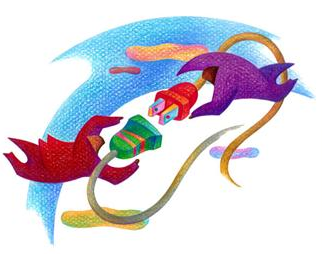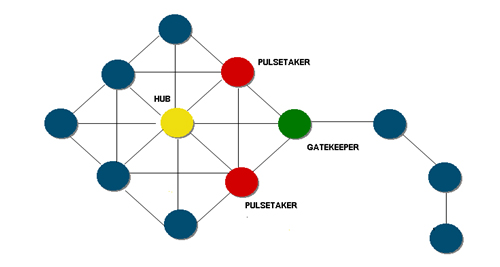
In our last article, we talked about the importance of the informal elements of the organization. Many valuable social networks exist within the informal part of the organization. Social Network Analysis (SNA) is a diagnostic methodology for uncovering and analyzing these networks and relationship patterns. When applied to business, SNA can be a powerful tool for enabling strategic organizational change and business transformation.
Also known as Organizational Network Analysis (ONA), SNA uncovers patterns of interaction by using mathematical analyses of human relationships and renders those relationships visually (click the network graphic below to see a visualization example*). As a result, leaders are able to literally see the quality of social networks within their organization and understand the human dynamics that are in play. This is important since healthy organizational networks can adapt quickly to change, can be reconfigured without significantly affecting productivity, and can disseminate information quickly.
SNA Software Tools
SNA methodology is enabled by powerful software applications that are available commercially and as open source. While SNA software has been around for years, it has just recently reached maturity. The software takes large amounts of internal company data and mines it (ala Google), analyzing hundreds and thousands of relationships to provide important insights that would otherwise go unseen within the formal organization. Here are a few of the SNA software applications currently available: Commetrix, Morphix, Socilyzer, and VennMaker.
How It Works
SNA uses metrics to provide insight into individuals’ and groups’ roles within the broader social network. Here are a few of the measurements that are most important for analysis:
- Degree – The count of the number of ties that an individual has to other nodes in the network.
- Betweenness – The extent to which an individual sits between other nodes in the network. This measure takes into account the connectivity of the node’s neighbors, giving a higher value for nodes which bridge clusters. It reflects the number of people who a person is connecting indirectly through their direct links.
- Closeness – The degree to which an individual is near all other individuals in a network (directly or indirectly). It reflects the ability to access information through the “grapevine” of network members.
 Based on these and other key metrics, the SNA software can reveal important unofficial roles in the social organization, such as the following:
Based on these and other key metrics, the SNA software can reveal important unofficial roles in the social organization, such as the following:
- Hubs – These people have significant influence over the network. A network centralized around a well-connected hub can fail abruptly if that hub is disabled or removed. Conversely, hubs often make ideal change champions or superusers because of their ability to efficiently disseminate knowledge.
- Gatekeepers – These people span boundaries and connect disparate groups. They serve as the links between departments, functions and groups. They act as information gateways and they broker knowledge between critical parts of the organization.
- Pulsetakers – These people have maximum influence using the minimum number of direct and indirect contacts (<three steps away). They are in a good position to monitor the information flow and have the best visibility of what is happening in the network.
Benefits to Organizations

SNA can provide significant business benefits, particularly when an organization is preparing to undertake a major organizational change at the product/market/geography level. Here, SNA can help the organization get the benefits from the change while mitigating risks. SNA can also help an organization that knows it needs to change, but is not sure in which direction to go – by providing a cost-effective way of defining a vision of the future which many stakeholders will agree with. SNA can also help an organization which has grown quickly and needs to establish a formal organization without disrupting the creative essence of what made it grow rapidly in the first place.
As part of an overall change management strategy, SNA can help illuminate knowledge flow as it relates to the case for change and future vision. It can help identify change champions, change managers, and natural self-support networks. SNA can also highlight individuals with high degrees of informal power who have the ability to resist the change. Over the longer term, SNA can monitor interactions and highlight where fine-tuning of the culture may be required to help embed the change.
In Summary
SNA is being used increasingly by change professionals as part of their portfolio of tools, and in their dealings with business leaders and HR business partners who are charged with delivering major change at low risk by maintaining employee engagement. If you are interested in hearing more about SNA as it relates to organizational change strategy, please post a comment below. Also, if you have used SNA tools first-hand, our readers would appreciate hearing about your experience.
*Source: Commetrix website (http://chacini.cs.tu-berlin.de/Commetrix/Clusterednetwork2d-view4.png)












5 comments
Bill Casey
at 3:25 pm
Jesse, I’ve done a little work in SNA, and what you have here is a SUPERB summary. Thank you for this clear, concise and comprehensive piece! This is an under-utilized technology.
Jesse Jacoby
at 8:57 pm
Bill,
Thanks for stopping and for weighing in on the topic. I’ve had some clients comment that SNA/ONA is “overkill” or “too rigorous” for their needs. I think it makes sense if the project is big enough (i.e., a large enough # of stakeholder impacted). I’d be curious to know what level of receptivity/enthusiasm for SNA your clients have expressed.
-J
Pingback: AdaptableOrg » Predictions
Bill Casey
at 9:54 pm
Well, it’s a sad story, Jesse. My client uses SNA rigorously on their competition; I recommended they use it on themselves (large, siloed organization) and the idea grew legs for a while, but they ultimately decided it would be too intrusive (we had planned to use intra-organization emails).
Internally, they have been accused of “not connecting the dots,” and their usual prescription for that malady is to move one manager over multiple functions, which usually has had only marginal success. SNA offered a potential dependent measure to gauge the effectiveness of a spectrum independent variables. Pity.
BTW, in regard to its being “overkill,” we found that there was absolutely a continuum SNA approaches that produced a continuum of data fidelity (and effort), from quick & dirty, to painfully precise & academic. It doesn’t have to be a science project.
Jesse Jacoby
at 10:05 pm
Much appreciate the additional color commentary! It’s encouraging to hear that SNA/ONA doesn’t always need to be a laborious effort with scientific-level analytics. I find many organizations and leaders prefer the more pragmatic approach (vs. the perception of an over-engineered solution), so this is good news. Thanks!